Samsung Galaxy Note 4 4G+: More than big
Samsung finds itself in a precarious situation this year with two bigger iPhone 6 models breathing down its neck. Can Samsung, the company who started the phablet craze, defend its turf with the Galaxy Note 4 4G+? Let's find out in this detailed review!
By HardwareZone Team -

Overview
It has been three years since Samsung carved out the phablet category with its first Galaxy Note. Even though many phone makers (ASUS, HTC, Huawei, Nokia, Oppo, Sony and Xiaomi) have since jumped onto the bandwagon to deliver similar offerings, Samsung's Galaxy Note series continue to be the more popular choice, and more units are sold with every new generation.
However, this year, the playing field changes as Apple entered the fray with its 5.5-inch iPhone 6 Plus. Apple's new iPhone 6 models have had record breaking pre-orders and weekend sales, potentially putting a damper on Samsung's sales figured for the Galaxy Note 4. They need the Galaxy Note 4 to be a mega success to reverse falling profits and stay ahead of the competition.
Can the Galaxy Note 4 fend off the iPhone 6 Plus and bring up profits for Samsung? We'll soon find out, but before that, here's a quick look at four generations of Samsung Galaxy Notes:
Design & Handling
(Note: We've done a hands-on article with the Note 4, so we'll only summarize the key points and additional observations here.)
The Galaxy Note 4 is among the new devices from Samsung that finally embraces a new design language that includes the use of metal. This concept was first introduced in the 4.7-inch Galaxy Alpha, believed by many to be an alternative to the 4.7-inch iPhone 6.
With the Note 4, the metal frame lends a premium look and feel. While it may not be fully clad in metal like the competition such as the HTC One (M8), the move will definitely please consumers wanting more from Samsung's flagship phones and is something we can definitely agree upon.

The Samsung Galaxy Note 4 is dressed in a metal frame.
Another area of improvement is its rear cover. The Note 4 retains a soft-textured back design, but Samsung has done away with the faux leather feel and fake stitching along the rims. While initially incorporated as a touch of luxury, some have found it to be tacky. This new cover on the Note 4 solves that concern and while it may look like a minor change, it does make it more professional and business-like. It also helps that it actually feels better to the touch.

No more leather stitching on the Samsung Galaxy Note 4 (left).

The rear cover is removable, giving you access to the 3,220mAh battery, micro-SIM and microSD card slots.
As with most Samsung's smartphones, the rear cover and battery are removable; there is a slit at the top left corner for you to easily pry open the cover. You'll get micro-SIM and microSD card slots to the left of the battery, and the Note 4 is able to support microSD cards up to 128GB in capacity, which means a maximum storage size of 160GB (inclusive of the 32GB internal storage).

Out of the box, the Note 4 comes with 23.7GB of available storage space. The Android OS and Samsung's TouchWiz take up about 7.4GB,
Besides this, there are three other physical hardware changes to the Note 4 that you should know of. The first is the addition of a heart rate sensor below the rear camera, while the second is a slightly bigger Home button due to the integration of an embedded fingerprint scanner. Lastly, Samsung has reverted to a standard micro-USB 2.0 port on the Note 4 - the Note 3 came with a USB 3.0 port instead. We're not quite sure why they took a step backward as USB 3.0 is infinitely speedier when transferring larger media files, which you're bound to have on a premium device like the Note 4.

Like the Galaxy S5, the Note 4 sports a heart rate sensor below the rear camera.

It's strange to see Samsung reverting to the USB 2.0 standard on the Note 4 when the Note 3 uses the newer 3.0 standard.

As the Home button of the Note 4 houses a fingerprint scanner, it is noticeably bigger in size than that of the Note 3.
Physically, while Apple has been battling their #Bendgate issues on social media, Samsung's Note 4 has not escaped the scrutiny of internet sleuths. According to Korean publication iTToday, some Note 4 owners reported a gap between the screen and metal frame. Apparently, the gap is big enough to fit a business card. We did a check on our review unit of the Note 4 and these are our findings:

Gaps can be seen on the top, right and bottom sections of the Note 4. We also spotted some dust and lint collected at these gaps.

The bottom right corner of our review unit has the gap too.
Before you jump to any conclusions about quality issues, it is noteworthy to mention that Samsung has acknowledged and even addressed this gap issue in its manual for the European Note 4. Thanks to Android Central, we have a glimpse of what the manual actually highlights:
This gap is a necessary manufacturing feature and some minor rocking or vibration of parts may occur. Over time, friction between parts may cause this gap to expand slightly.
A Samsung spokesperson told Android Central that the gap issue "does not impact the functionality or quality of the Galaxy Note 4". The Note 4 is not the only device facing such problems; the HTC One suffered from a gap issue between its cover and main body in 2013 while some local users of the Sony Xperia Z2 reported gaps between the front panel and frame of the device.
In terms of handling, the Note 4 fared pretty well against the 5.5-inch iPhone 6 Plus. We found the Note 4 easier to use in one hand thanks to a combination of hardware and software innovations. Despite having a larger 5.7-inch display, the Note 4 is approximately 5mm shorter and just a mere 0.8mm wider than its Apple counterpart. However, the Note 4 couldn't match the standards set by LG; its 5.5-inch G3 is 7mm shorter, 4mm narrower and 27g lighter. To date, the LG G3 still offers us the best large screen handling experience.

The front view of the phablets. <br> From left to right: Apple iPhone 6 Plus, Samsung Galaxy Note 4 and the LG G3.

The rear view of the phablets. <br>From left to right: Apple iPhone 6 Plus, Samsung Galaxy Note 4 and the LG G3.

The Samsung Galaxy Note 4 (right) has a slightly bigger display at 5.7-inches, but the 5.5-inch Apple iPhone 6 Plus (left) is taller.

Faux leather back or an aluminium rear? It's your decision.
5.7-Inch Quad-HD Super AMOLED Display
The Note 4 is the first Samsung's smartphone with a Quad-HD display to enter our market. Earlier this year, we had hopes that Samsung would bring in the Galaxy S5 LTE-A (SM-G906 SKU) model with a 5.1-inch QHD display. Unfortunately, only the Galaxy S5 4G+ (SM-G901) with a Full-HD display made it to our shores.
And it's one of the few times that Samsung has been late in the game; two other smartphones - the LG G3 and Oppo Find 7 - made it to our market with QHD displays a few months ahead of the Note 4. Better late than never, right? Still, as noted in our reviews or the LG G3 and Find 7, the bump in resolution doesn't necessarily equate to a noticeable improvement in viewing experience unless you place the Note 4 beside the Note 3. Even then, you have to look closely at the same content to discern the differences.

The display of the Samsung Galaxy Note 4 (bottom) delivers richer colors and looks more saturated compared to that of the Apple iPhone 6 Plus (top). Look closely at the reddish orange and purple hues at the bottom left corner of the displays.
Pixels aside, there is an obvious improvement to the viewing experience and feel of the display that has nothing to do with resolution. Samsung decided to bring the 2.5D glass used on the Galaxy S III to the Note 4. As the glass is curved around the edges, swiping is smoother and gives a nicer feel compared to the Note 3. Unlike the iPhone 6 and 6 Plus where the glass panels seamlessly join the rounded edges of the aluminium chassis, the chamfered edges can feel a little sharp when you swipe to the edge.

The touch screen experience is slightly better on the Apple iPhone 6 Plus (top) as the screen seamlessly joins the sides of the device.
If you are concerned about over saturation on AMOLED displays, you can be well assured that the Note 4 gives you the option to select the best viewing mode to suit your usage. This is done through Adaptive Display, first found on Samsung's Galaxy Tab S tablets. Here's an excerpt from the review of the Galaxy Tab S 10.5 (LTE) on how Adaptive Display works:
Adaptive Display is developed by Samsung to automatically optimize the gamma, brightness, contrast and sharpness to suit different usage scenarios. You also have three other modes to select from: AMOLED Cinema, AMOLED Photo and Basic mode. AMOLED Photo mode is perhaps more suitable to attain a more balanced color saturation profile that some might prefer.
Overall, the 5.7-inch QHD Super AMOLED display on the Note 4 offers top-notch visuals with vivid colors, good color contrast and excellent viewing angles.
New smoother flavor of TouchWiz
Like most recent Android smartphones, the Note 4 ships with Android 4.4.4 KitKat. Samsung also preloads its latest version of TouchWiz on the Note 4, which looks aesthetically more pleasing and feels smoother than past versions. The same interface can also be found on recent Samsung phones such as the Galaxy Alpha and Galaxy S5. Here are some screenshots comparing the differences of TouchWiz between the Note 4 and Note 3:
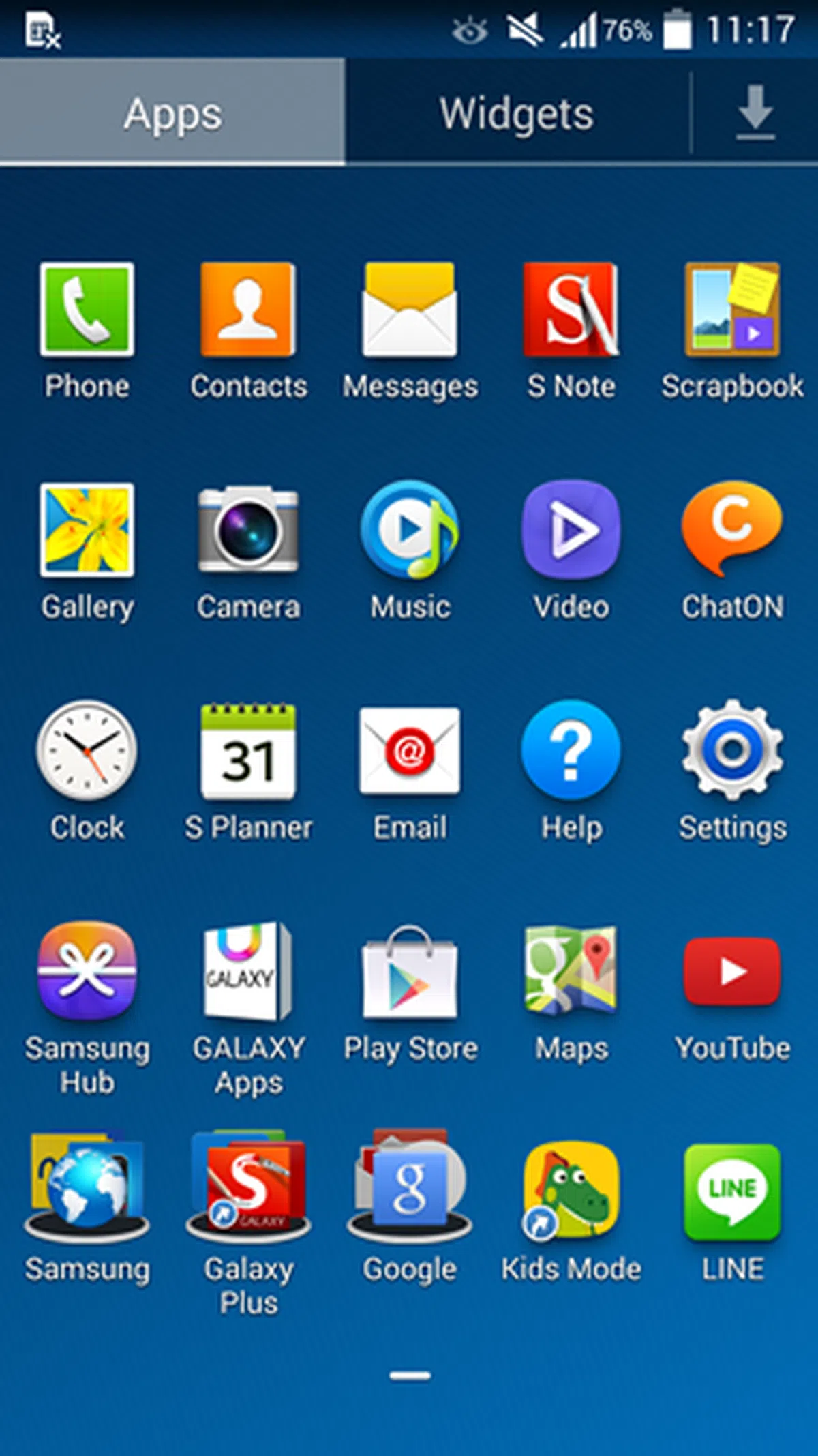 | 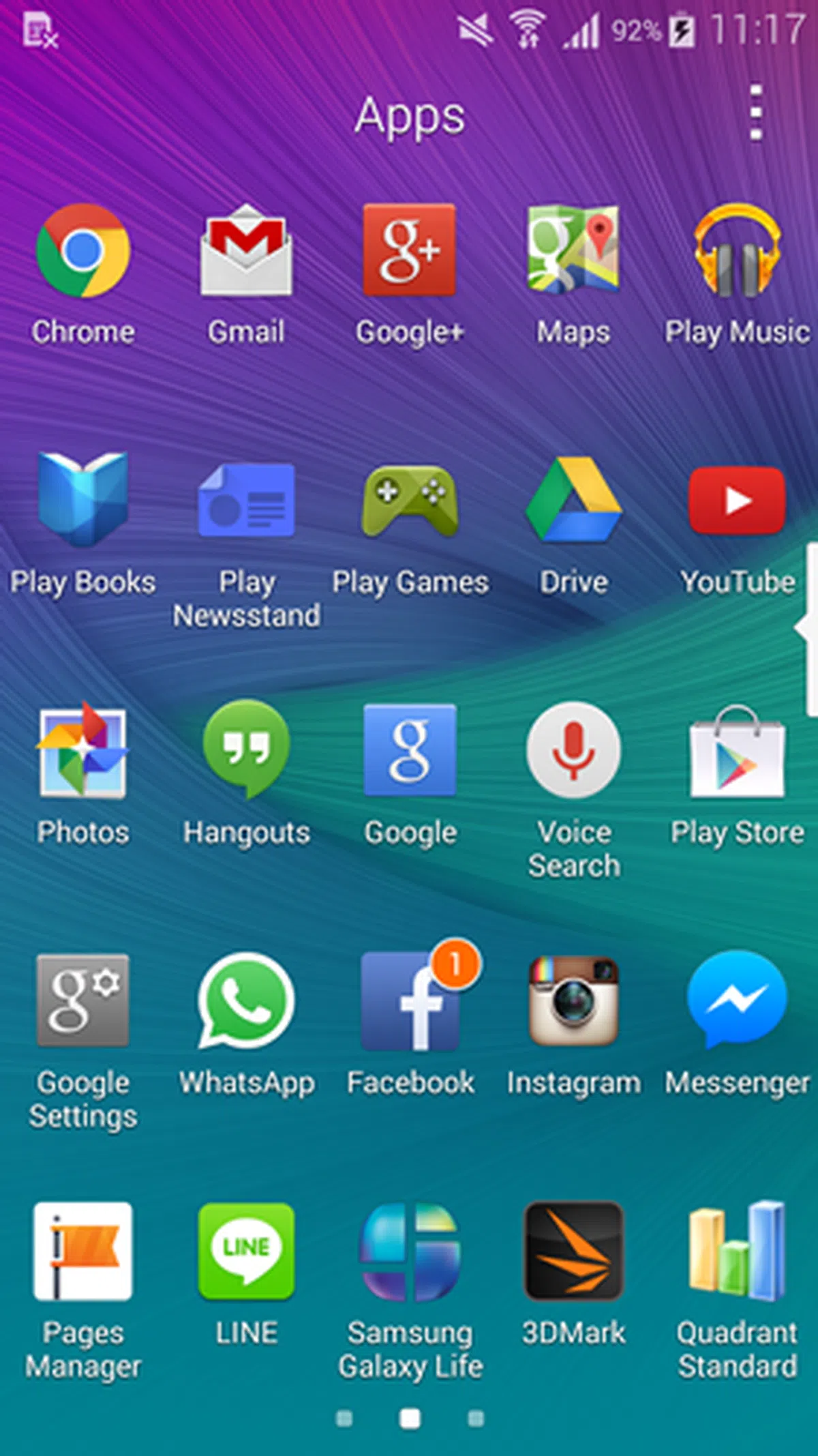 |
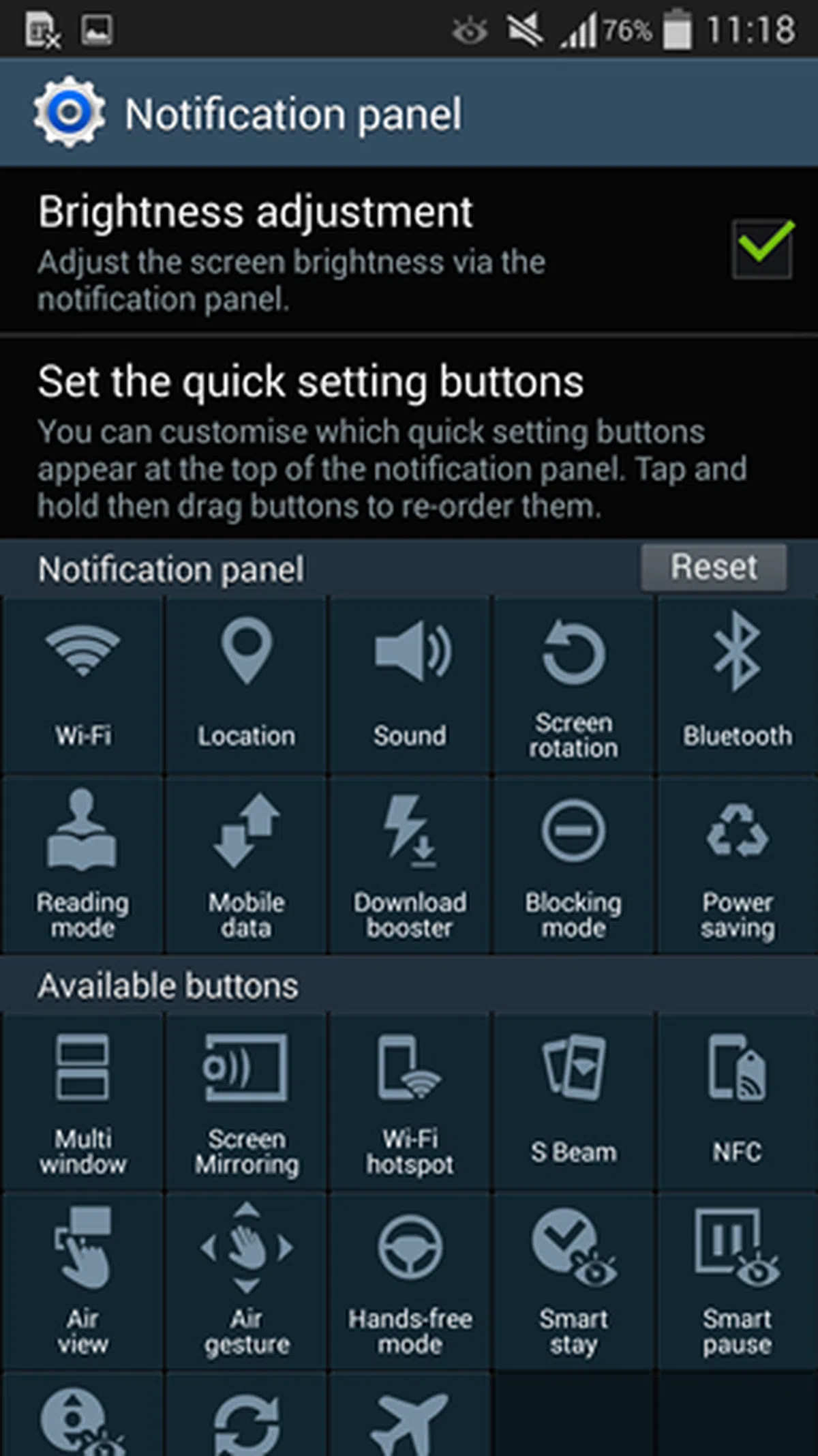 | 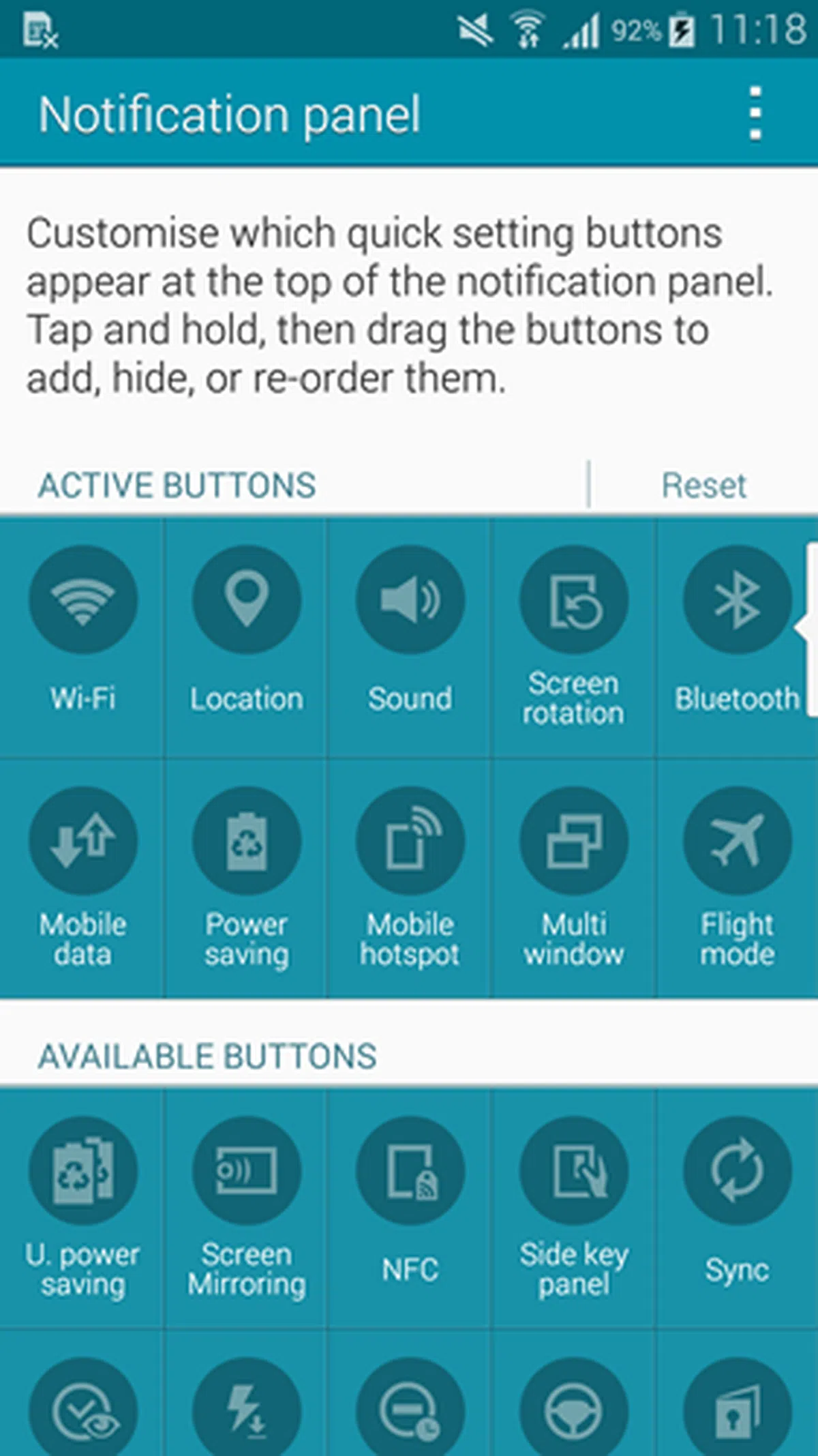 |
S Pen becomes more powerful
Since the S Pen is the main feature setting the Galaxy Note series apart from the competition, Samsung made it a necessity to enhance the functionality of its stylus pen with each iteration. As a quick recap, the Note 3 introduced Air Command, which allowed you to quickly execute five S Pen-related features (Action Memo, Scrap Booker, Screen Write, S-Finder, and Pen Window). For more information on Air Command, do check out the software section of our review on the Note 3.
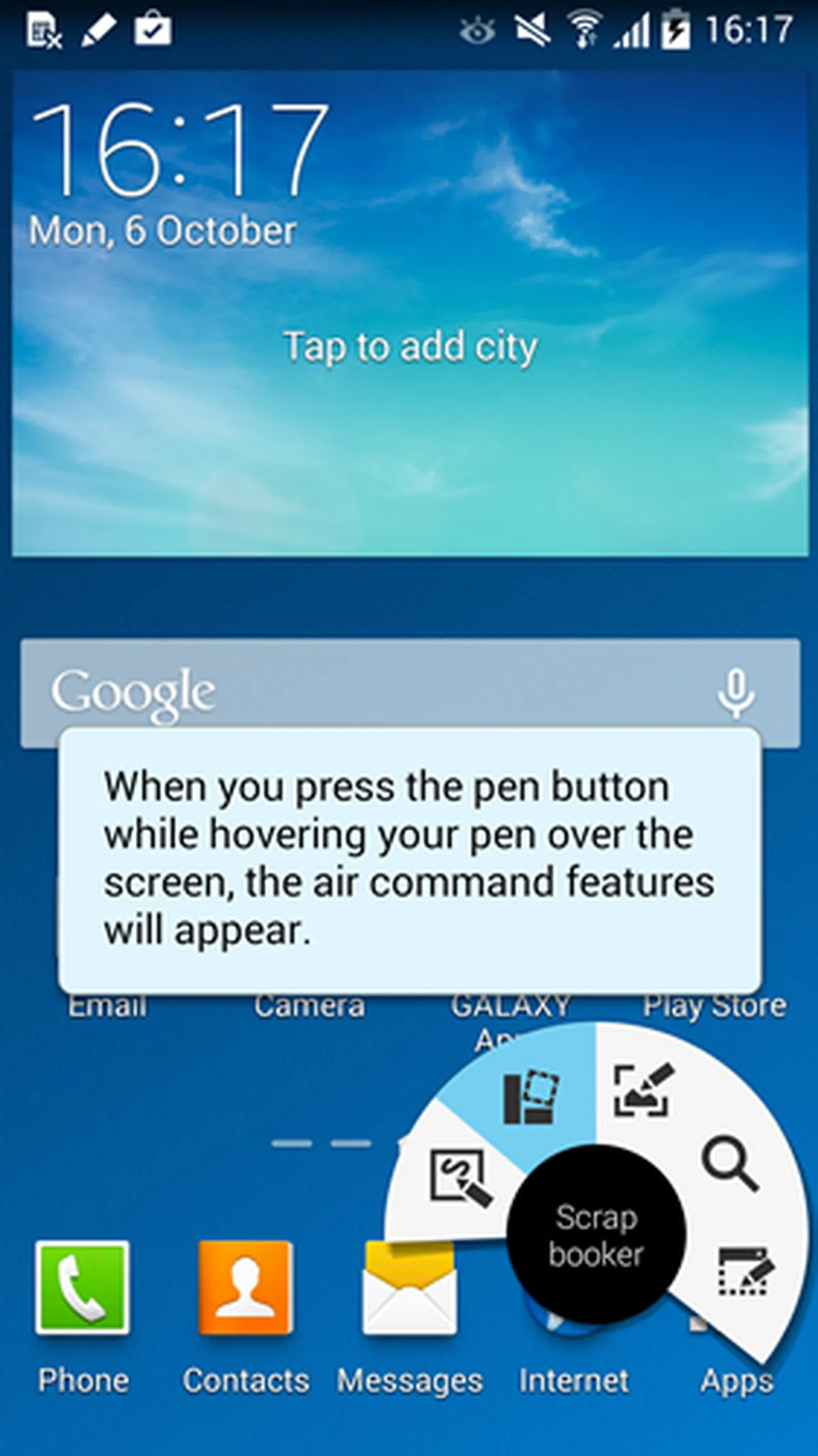 | 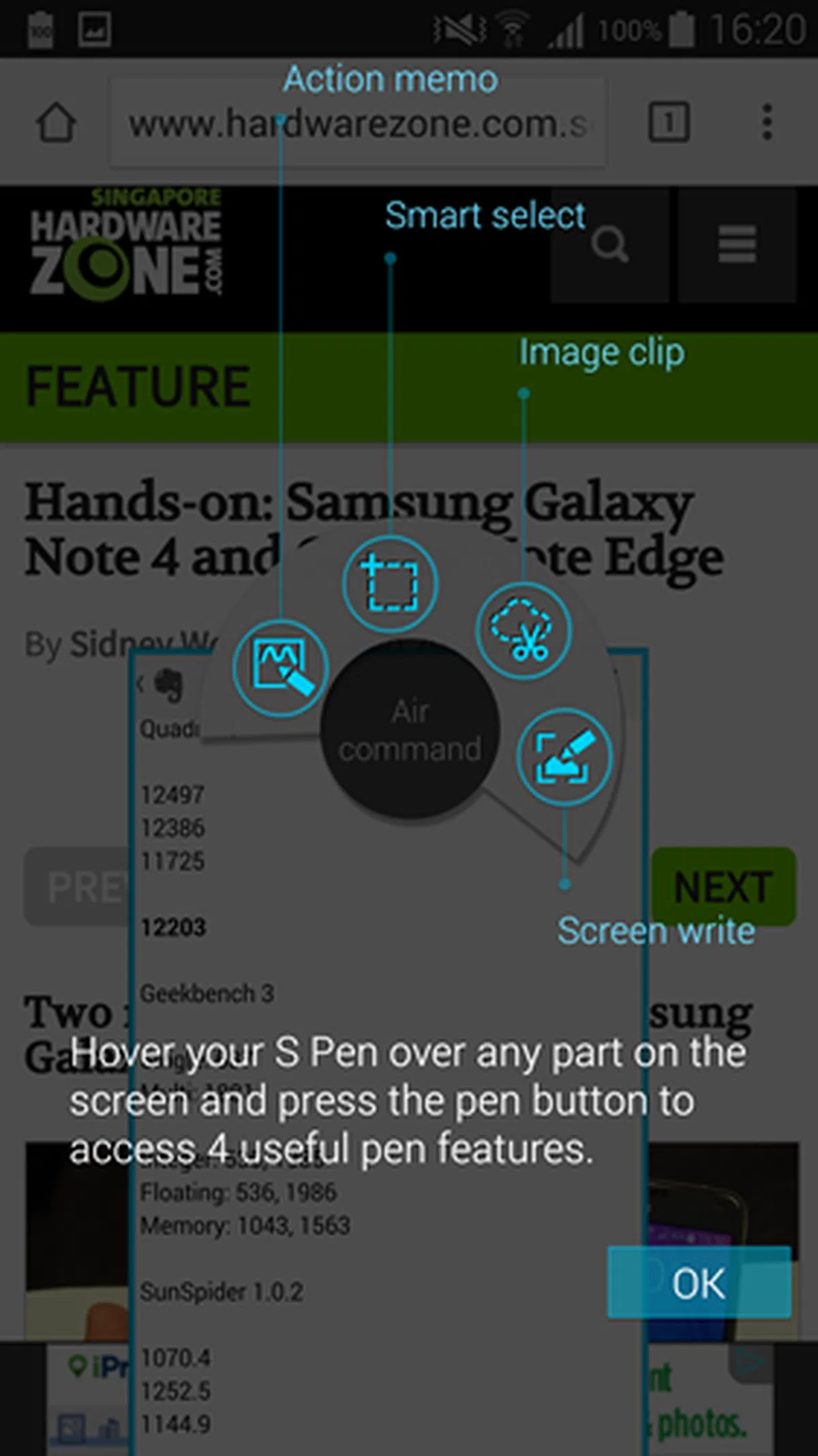 |
On the Note 4, the Air Command feature is still present although it has been reduced to four features - Action Memo, Smart Select, Image Clip and Screen Write. A new feature offered is Smart Select, which lets you crop or choose a particular segment/section from different sources such as a website, a photo and a text message, and share the content easily. Below is a short video showing how Smart Select works:

Depending on the content that you selected, you are offered a variety of links to apps and other functions via Meta text. For example, if you select a paragraph of text from an article to share, the Note 4 will offer Smart Suggestion such as the URL link and browser bookmark. If you are reading up on a particular hotel to book for your holiday trip, Smart Suggestion can extract the relevant information such as the address and location details to be shared.

In this screenshot, we chose to crop a section from our hands-on article. Smart Suggestion then offered us the option to share, the URL and bookmark for the browser.
The S Pen also has another new feature which allows you to drag and select multiple files on the Note 4 in selected applications such as Gallery, My Files, Browser, S Note and S Planner. We found this feature quite useful especially when sharing multiple photos with friends. The ability to select a group of photos in the Gallery in one step saves time and effort compared to manually selecting with your finger. Below is a video showing this feature in action:

Improved touch and sensitivity
The S Pen from the Note 3 is already one of the best in the industry with 1,024 levels of sensitivity, allowing users to doodle and sketch almost anything with a reasonable amount of precision. The S Pen that comes with the Note 4 comes with a whopping 2,048 levels of sensitivity, doubling its predecessor, and offers a more authentic writing experience.
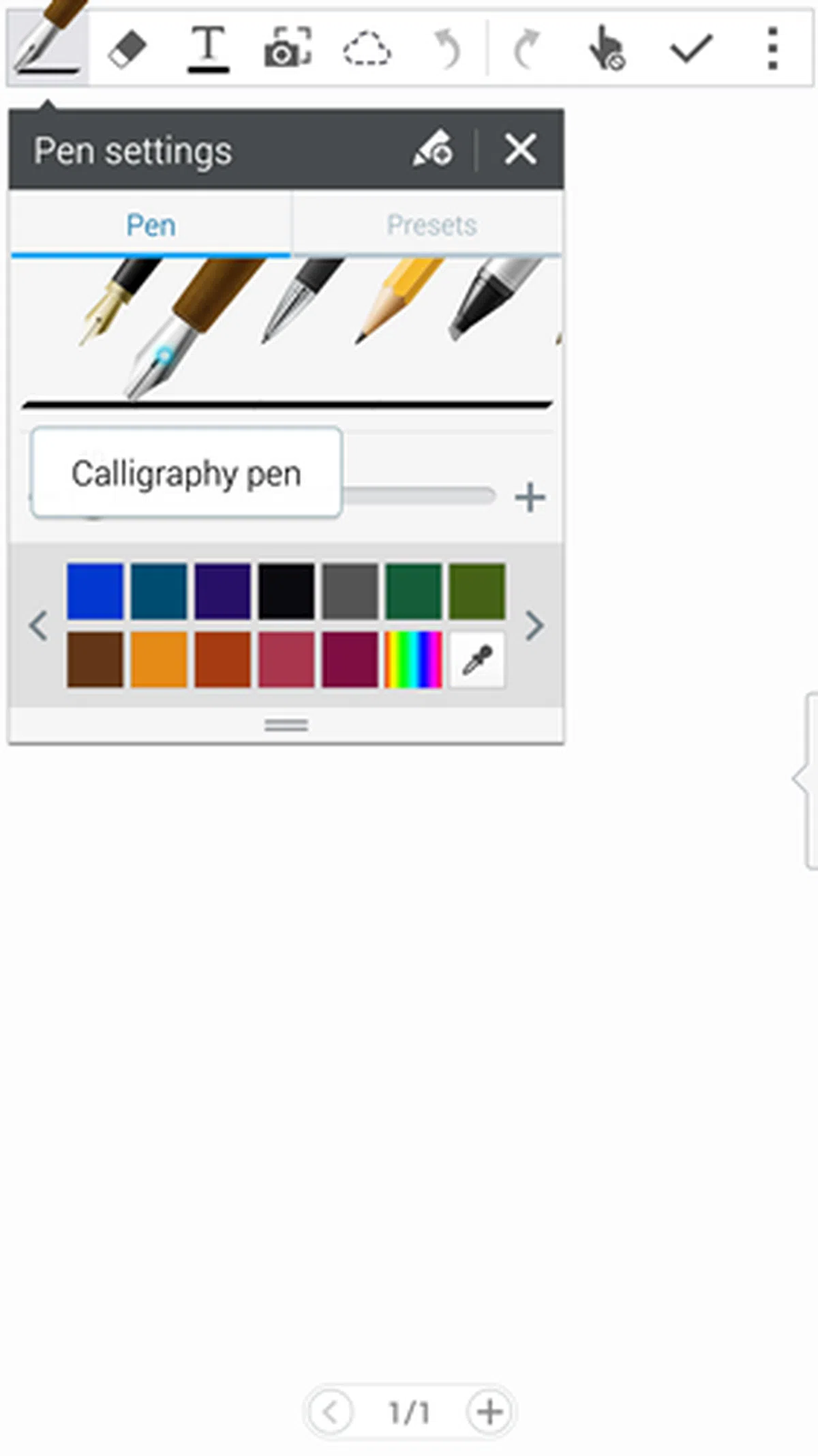 | 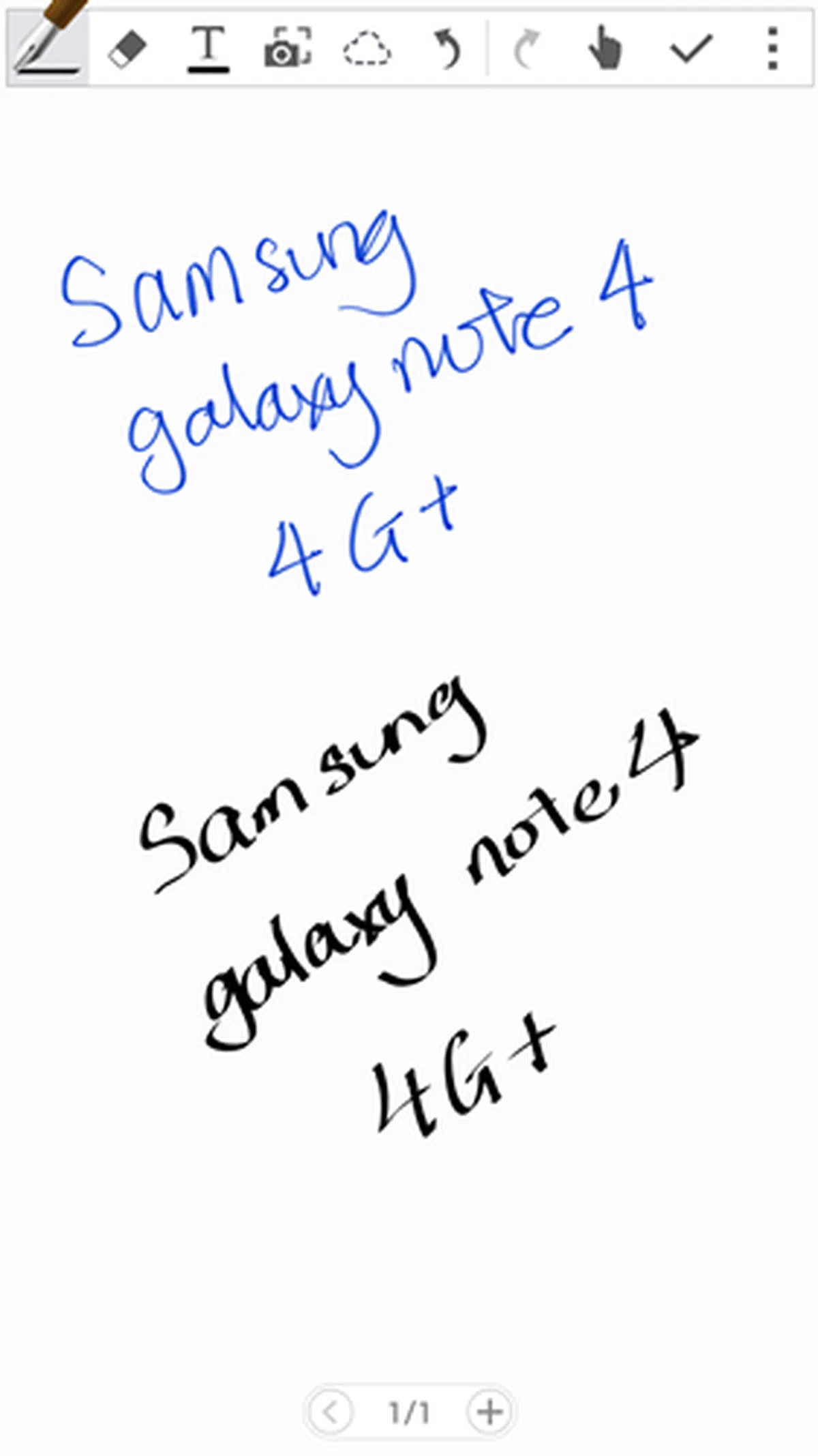 |
Improved Multitasking
Multi window (also known as split window view) has been a standard feature on the Galaxy Note series since the Note II and Samsung has since redesigned it to be accessed much faster and easier. Previously, you needed to long press the Back button to activate a side bar where you can choose two apps from a list to run simultaneously. This method is still present on the Note 4, but you can now activate it by simply tapping on the Recent Apps button. Apps that support multi window will have the split view icon on the top right corner of the panel.

The new method is more intuitive for users to activate multi window on the Samsung Galaxy Note 4.
We find the new method to be much faster and more convenient in daily usage although we do hope that more third party apps can be supported. As seen in the screenshot above, Pulse News Reader does not support multi-window. Unexpectedly, the official Twitter app is not supported as well. Do also note that multi window has to be enabled in Settings > Multi Window.
Samsung also made it easier for you to activate pop up window on the Note 4. This can be done by using the S Pen or your finger and swiping down from the top left or right corner of the screen. Compared to the method used on the Note 3 where you need to use the S Pen to draw a small window anywhere on the screen to open an app in a small window, the new method is also faster. In addition, you can adjust the size of the pop up window, minimize it into an icon or revert it to full screen view.
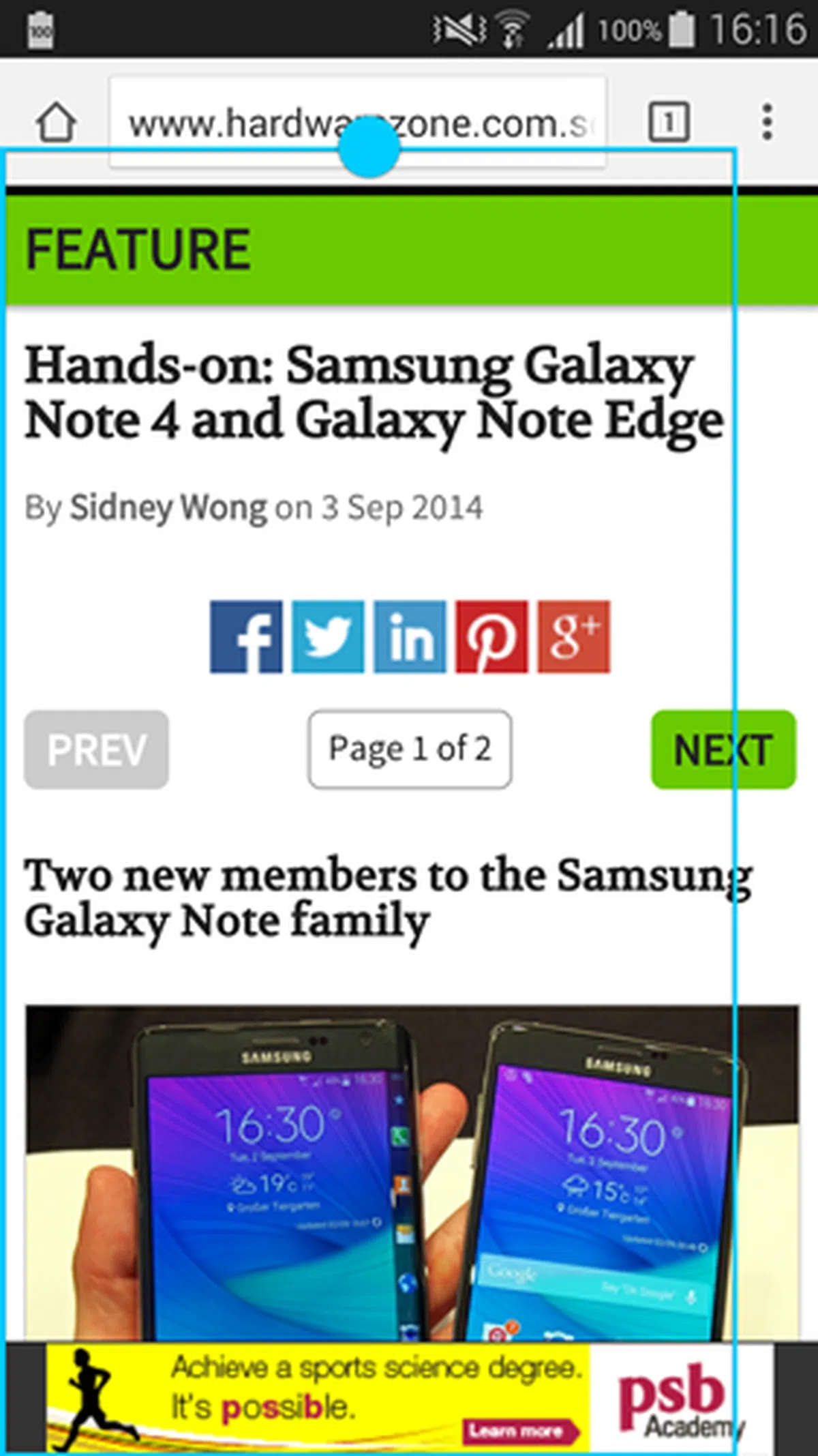 | 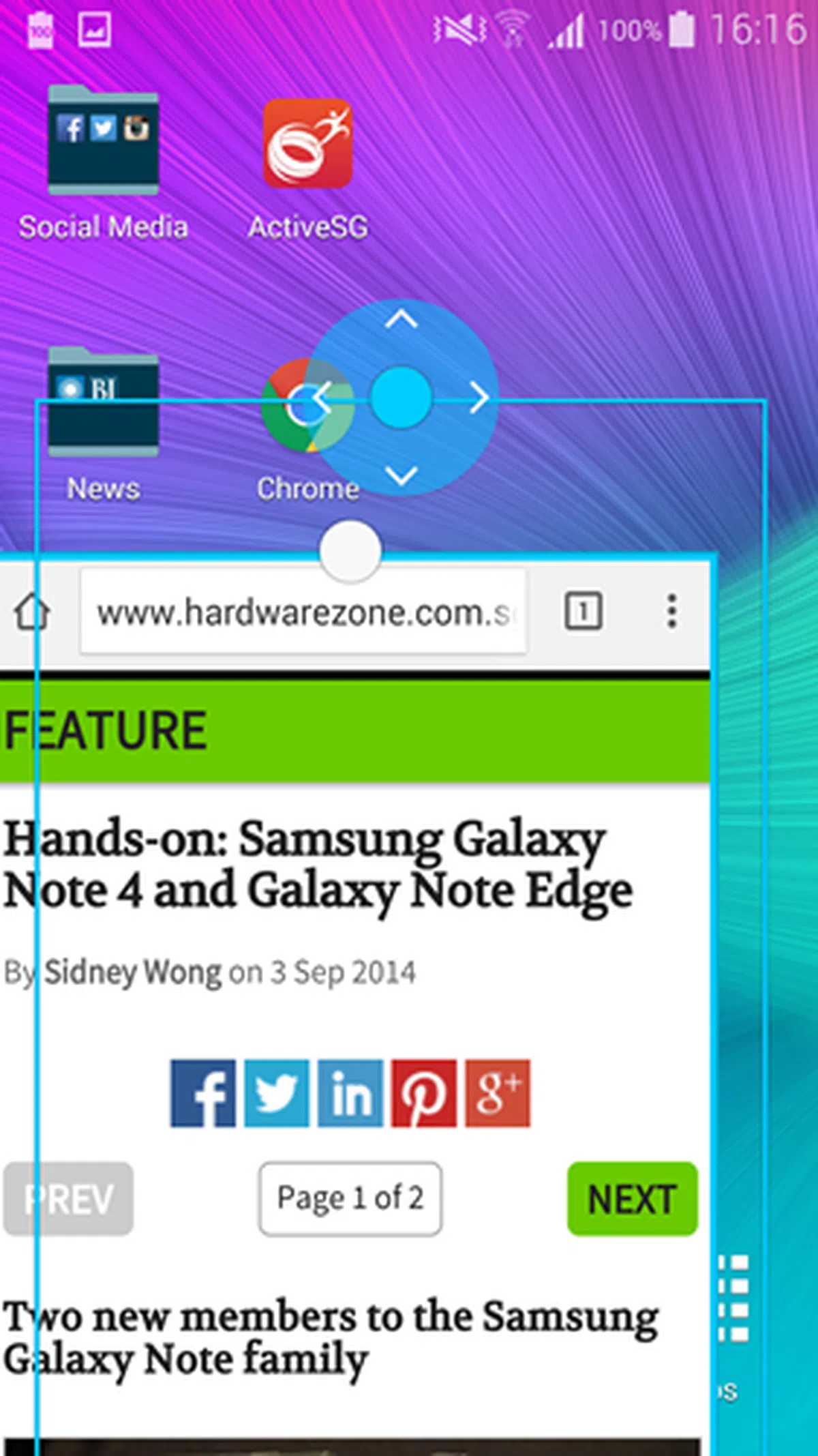 | 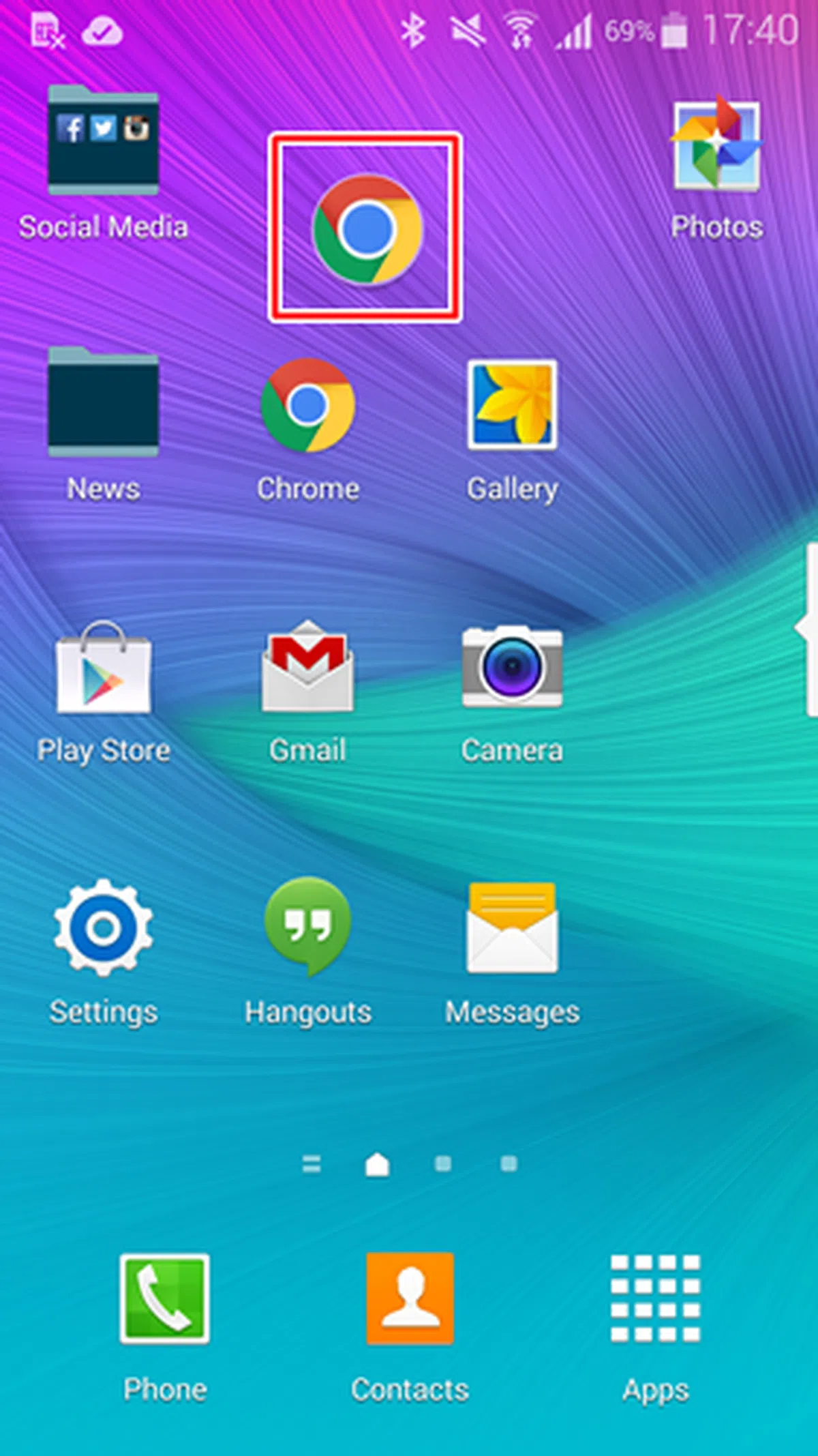 |
Side key panel for one-handed usage
The major concern when handling large display sizes have always been its awkwardness, especially if you're trying to use it with one hand. Most Apple users got their first taste of this phenomenon with the iPhone 6 Plus. To Samsung's credit, as a major proponent of phablet devices, the company has consistently worked on usability by refining interface and offering software workarounds through each generation of Note devices.
First introduced on the Galaxy Note II, users can already enable a special one-handed input mode (keypad, keyboard, calculator and unlock pattern). On the Galaxy Note 3, Samsung brought this to the next level by allowing users to adjust the scale and position of all screens by swiping the edge of the screen. Just when you thought Samsung had called it a day on this usability aspect, the Note 4 introduces the most practical one-handed solution yet - the side key panel.
By enabling the side key panel, you can have access to major navigation keys (Home, Back, Menu, Recent Apps), App List and Reduce Screen on the side for quick thumb access. Furthermore, the side key panel can be moved to the left or right side of the screen to suit the needs of different users.
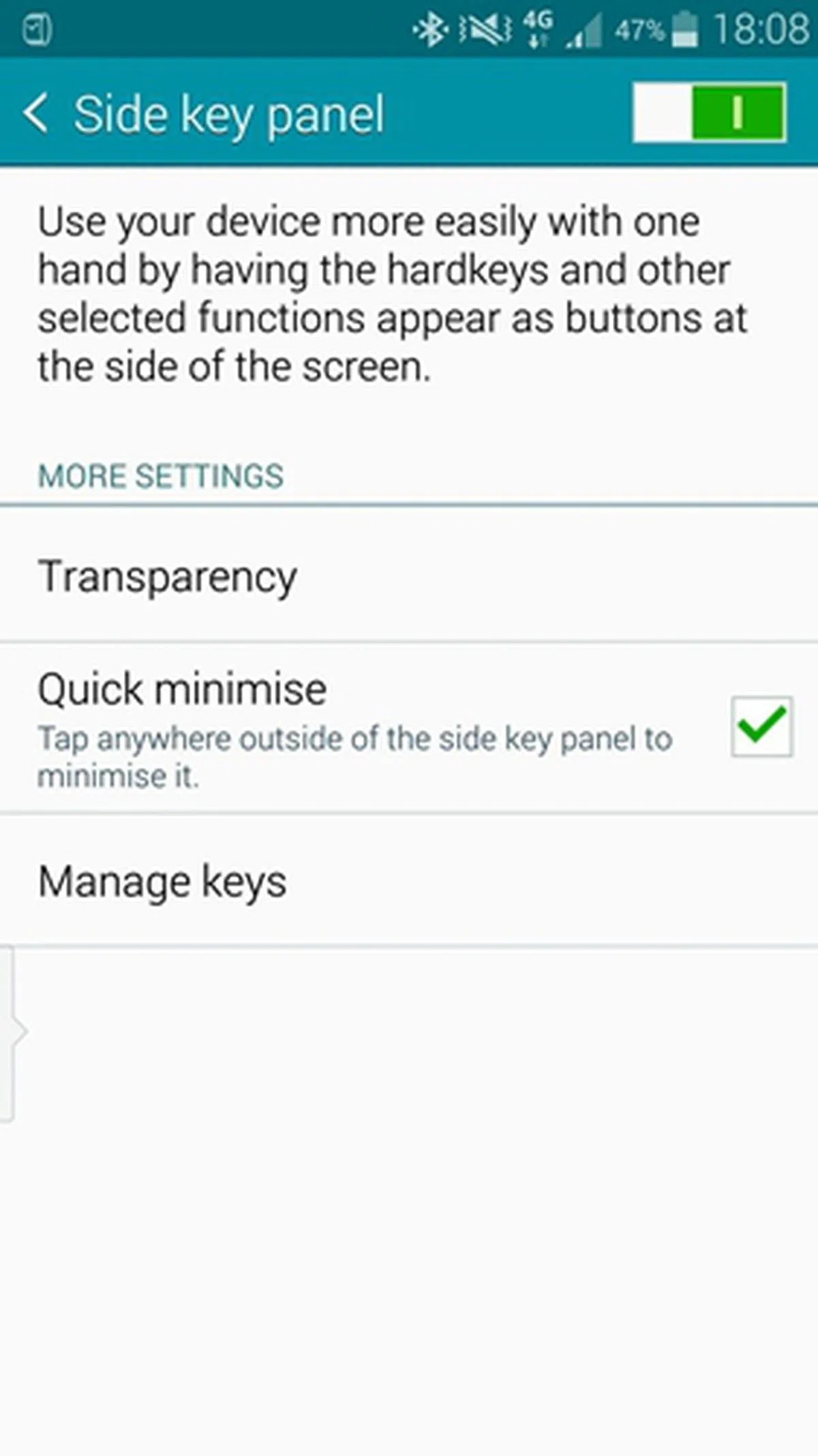 | 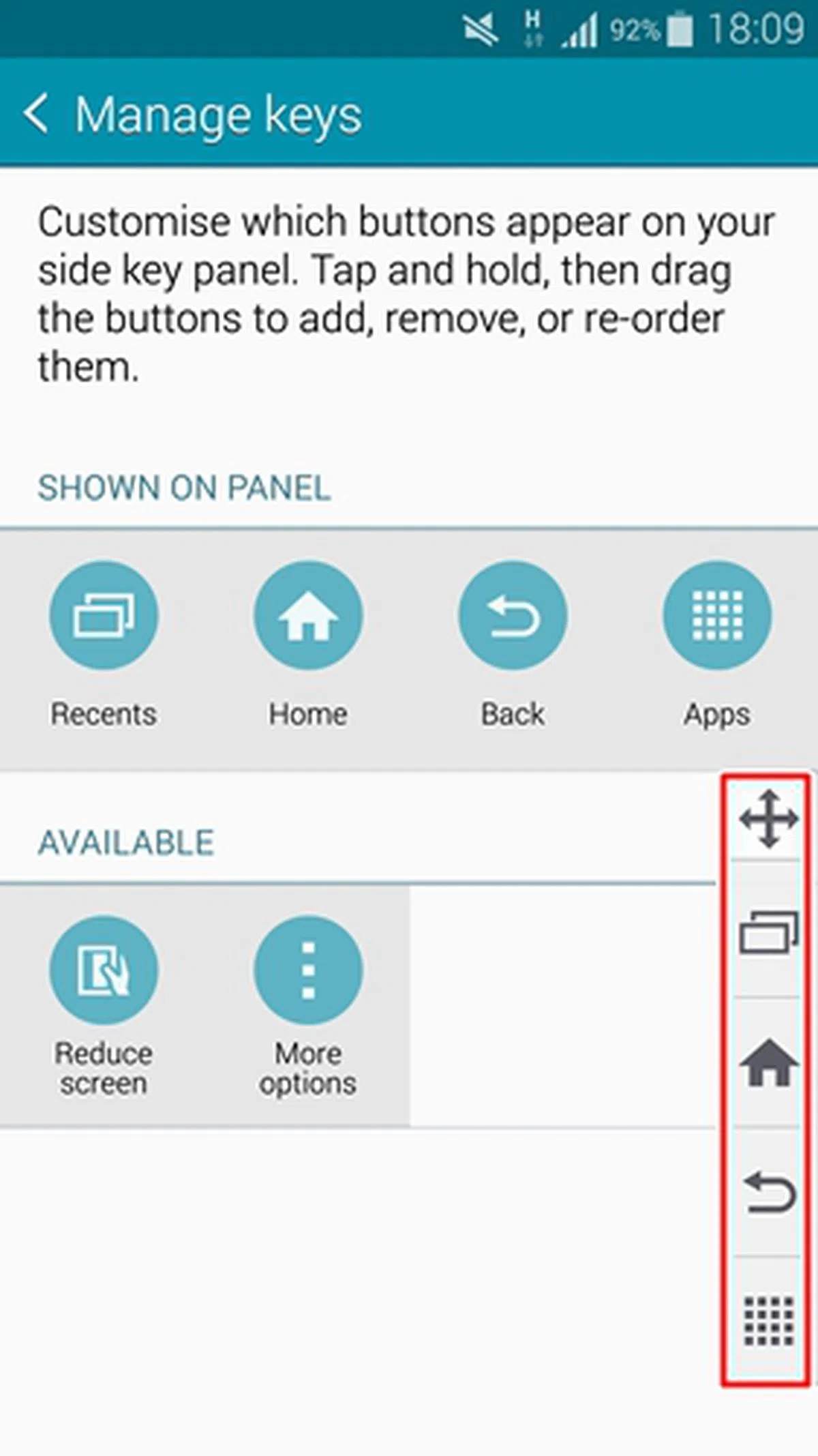 |
Of all the one-handed operation solutions we've seen so far, Samsung's side key panel is the most innovative and practical of the lot. While we initially kept reaching back to the hardware buttons for navigation, the side key panel gradually grew on us and we appreciated its functionality. It will not solve all the one-handed usage issues faced by phablet users, but it certainly made it easier to execute common actions on the Note 4 than competing devices.
Action Memo as a widget
For readers who are unfamiliar with Action Memo, it is actually a note-taking overlay which you can activate on any window or app. Not only can you take down notes and information quickly, you also can have access to 7 tasks - phone, contacts, messaging, @ (email), browser and to-do icons. On the Note 3, the Action Memo is saved as a stick-it note in the app. Now, you can pin the individual notes as widgets on the home screen.
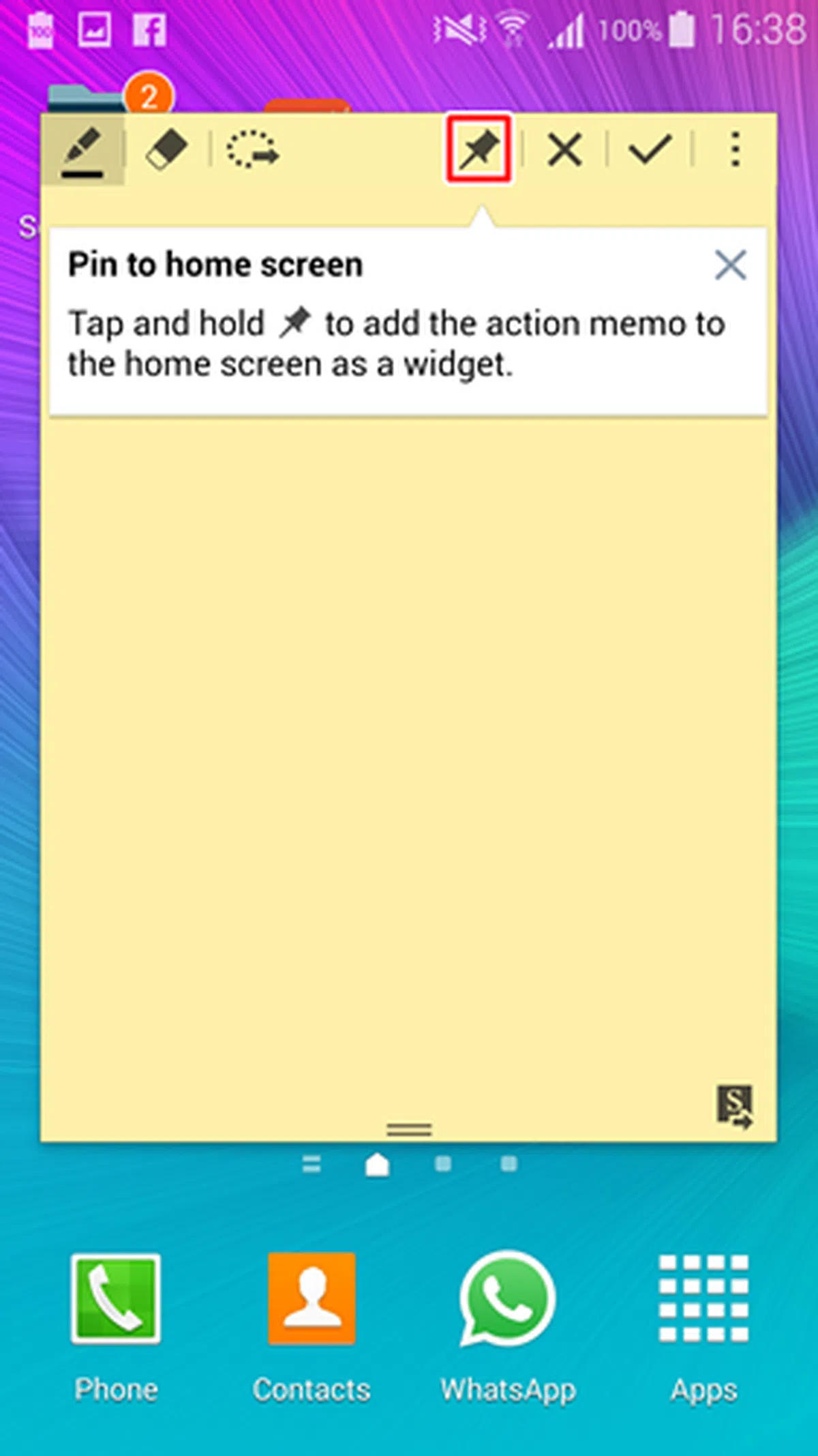 | 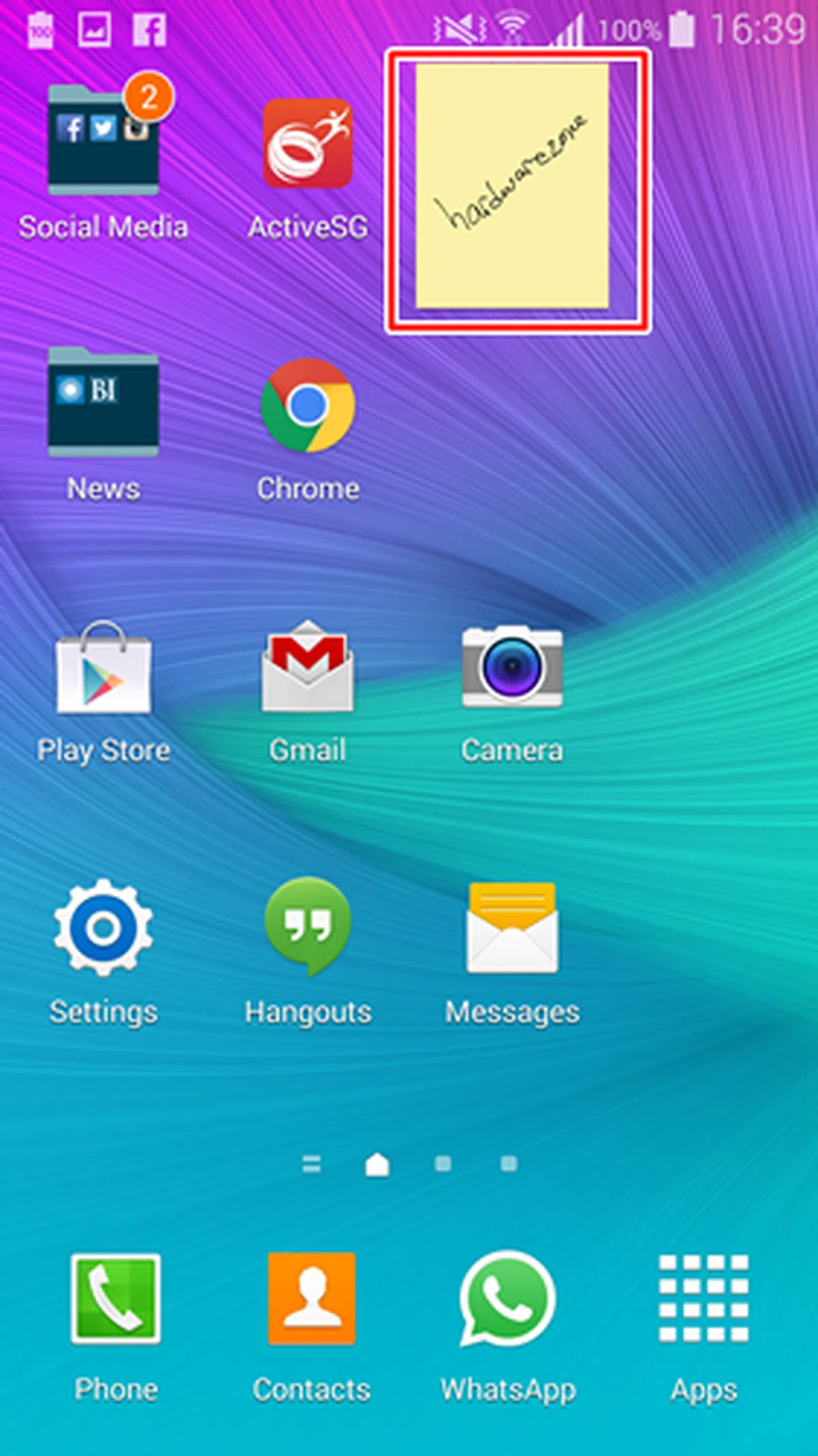 |
Photo Note
Even with the new enhanced S Pen and its software features, there are bound to be situations where you cannot simply jot down everything you see all the time. This is why the Note 4 now has Photo Note, a photo-taking feature that you can use to take a photo of the notes (with text and images) and convert them into digital content on the S Note to be edited.

When you start up the Photo Note on the Samsung Galaxy Note 4, it offers some tips on how to use the feature.

Align the subject within the blue rectangle box to get a proper render on the Samsung Galaxy Note 4.

After processing the image and placing it in S Note, you have the option to edit, crop, cut, copy or delete it.

To edit, you have to click on "Convert to edit". You can write, erase, add text, insert photo or select a particular area (lasso) to edit.
Overall, we find the experience of using Photo Note to be decent. While it does take some time for the Note 4 to process and convert an image into digital content for editing, Photo Note should be a handy feature for business professionals and students who need to capture meeting notes or lecture slides without having to write anything down.
Galaxy Gift Pack worth S$700
Similar to the Galaxy Tab Pro and Tab S tablets, the Note 4 comes with a free suite of apps that is said to be worth more than S$700. Dubbed Galaxy Gift, Note 4 users can download a range of paid apps for free from the following categories: productivity, entertainment, education, e-books, and lifestyle and others.
From the productivity category, you get Hancom Office 2014 for Android, Dropbox (two years' free 50GB storage space), a free 6-month subscription to Parallels Access, ArtRage (a toolbox of painting tools), free premium subscription to Pocket for 6 months, and free 6-month premium membership to RealPlayer Cloud.
Productivity | Entertainment | Education & e-Book | Lifestyle and others |
Hancom Office 2014 for Android
(free download office editor for unlimited period from Samsung Galaxy Apps) | AmpliTube
(turns your Note 4 into mobile guitar/bass) | Bloomberg Businessweek+
(Free first year of Bloomberg Businessweek+ ) | Workout Trainer
(Free six-month trial of Pro+ Premium membership) |
Dropbox
(Free 50GB online storage for two years) | Diddeo
(creating own music videos, free unlock frame feature) | New York Times
(Free subscription to the NYTimes with Breaking News for 12 weeks) | Life 360
(Free six months of Life 360 Premium) |
Parallels Access
(A free six-month subscription) | Gameloft
(Dungeon Hunter 4 game with $30 free in-app credit) | Wall Street Journal
(Free six months subscription) | Camera Ace
(Full premium features including smart frames, filters, hassle free slideshow for 3 months) |
ArtRage
(toolbox of painting tools) | OnLive
(Free three months of unlimited gaming) | Kindle for Samsung
(A free eBook every month through Samsung Book Deal) | Magisto
(Free three months of Magisto Premium) |
Pocket
(Free premium subscription for six months) | Audible
(Free three months of audio books) | Perfect 365
(Free animation effects) | |
RealPlayer Cloud
(Free 6 months of premium membership) | PayPal
($50 voucher to use on PayPal's merchant network)
| ||
TripAdvisor
(Four exclusive features for Note 4 users) | |||
SketchBook
(Free professional drawing toolkit) | |||
SPH Magazines
(Free 3 magazine issues) | |||
Toggle
(Pay $1 for two months of premium video content access which originally costs $19.80) |
Performance Benchmarks
The Note 4 is powered by a Qualcomm Snapdragon 805 quad-core 2.7GHz processor and 3GB RAM, which makes it the most powerful Android smartphone (on paper at least) in the market. The Galaxy S5 4G+ comes close with the same chipset, but at a lower clock speed of 2.5GHz and 2GB RAM. There is another variant of the Note 4 powered by the Exynos 5433 chipset, but it is not sold in Singapore.
With this much processing prowess, the Note 4 should run circles around the competition in terms of benchmark performance. For this review, we compare the Note 4 against the Note 3, LG G3, Oppo Find 7, and Apple iPhone 6 Plus. Let's take a look at the benchmarks right after this comparison table: -
Quadrant Results
Quadrant evaluates a device's CPU, memory, I/O and 3D graphics performance. The Note 4 fared 11% better than the Note 3 and Find 7 in the Quadrant benchmark, while pulling a 47% lead over the G3.

3DMark (2013)
Originally developed as a PC gaming benchmarking tool, 3DMark now supports multiple platforms including Android. The Ice Storm benchmark is designed for smartphones, mobile devices and ARM architecture computers.
For an in-depth understanding of 3DMark for Android, do head over to our article, "3DMark - Android Device GPU Performance Review." In a nutshell, it is an OpenGL ES 2.0 benchmark test that uses fixed off-screen rendering to run two graphics tests designed to stress the GPU performance of your device and a physics test to stress its CPU performance. The benchmark consists of three test portfolios:- Standard (720p resolution rendering), Extreme (1080p resolution rendering with higher quality textures and post-processing effects) and Unlimited (disabled v-sync, display scaling and other OS factors that make it ideal for chipset comparison).
Since all the recent flagship smartphones max out the scores for the Standard and Extreme tests, we will only be looking at the scores for Ice Storm Unlimited run. The Note 4 clinched the top spot in the benchmark with a score of 20,821, which is a healthy lead over the G3, Find 7 and the iPhone 6 Plus.

SunSpider Javascript
SunSpider Javascript helps measure the browsing performance of a device when processing Javascript. It not only takes into consideration the underlying hardware performance, but also assesses how optimized a particular platform is at delivering a high-speed web browsing experience.

Contrary to expectations that the Note 4 could fare as well or even better than the Galaxy S5, it only managed a middling performance in the SunSpider Javascript benchmark. The iPhone 6 Plus rules the roost here and it shows how well optimized Apple's platform is when compared to Android. Nevertheless, with the kind of raw power that the Note 4 has, we did not encounter any slowdowns when browsing the internet with the device.
Number crunching aside, the user experience on the Note 4 is great. While we encountered occasional stutters during multitasking, they were not significant enough to affect the day-to-day operation and experience. Overall, we are quite pleased with the performance of the Note 4.
Battery Performance
Our standard battery test for mobile phones includes the following parameters:
- Looping a 800 x 480-pixel video with screen brightness and volume at 100%
- Wi-Fi and Bluetooth connectivity turned on
- Constant data streaming through email and Twitter
The Note 4 lasted a whopping 14 hours and 48 minutes in our battery test, which is by far the best battery performance in our records of any phone, ever. The previous record holder was the Motorola Razr Maxx with an up-time of 864 minutes - and that was all the way back in 2012. Compared to its QHD counterparts (the LG G3 and Oppo Find 7), the Note 4 lasted at least two times longer.
Its record breaking battery mileage can be attributed to its lower power consumption of just 0.84 watts, which is in turn attributed to Samsung's extremely efficient AMOLED display. Since the other phones utilize LCD panels, their power consumption in use were much higher.


Portability
We measure the portability of a device by calculating its battery life to (weight x volume) ratio. Despite the Note 4 being the heaviest of the lot, it managed to pull ahead of the pack and edged out the Note 3 in the Portability Index. Its excellent battery mileage more than made up for its heft and form factor.

Real World Usage Performance
Benchmarking only provides a theoretical view of a performance assessment though. For a more realistic understanding on how the Note 4 fared under real world usage conditions, here are some screenshots of usage and history graphs of our time with the phone.
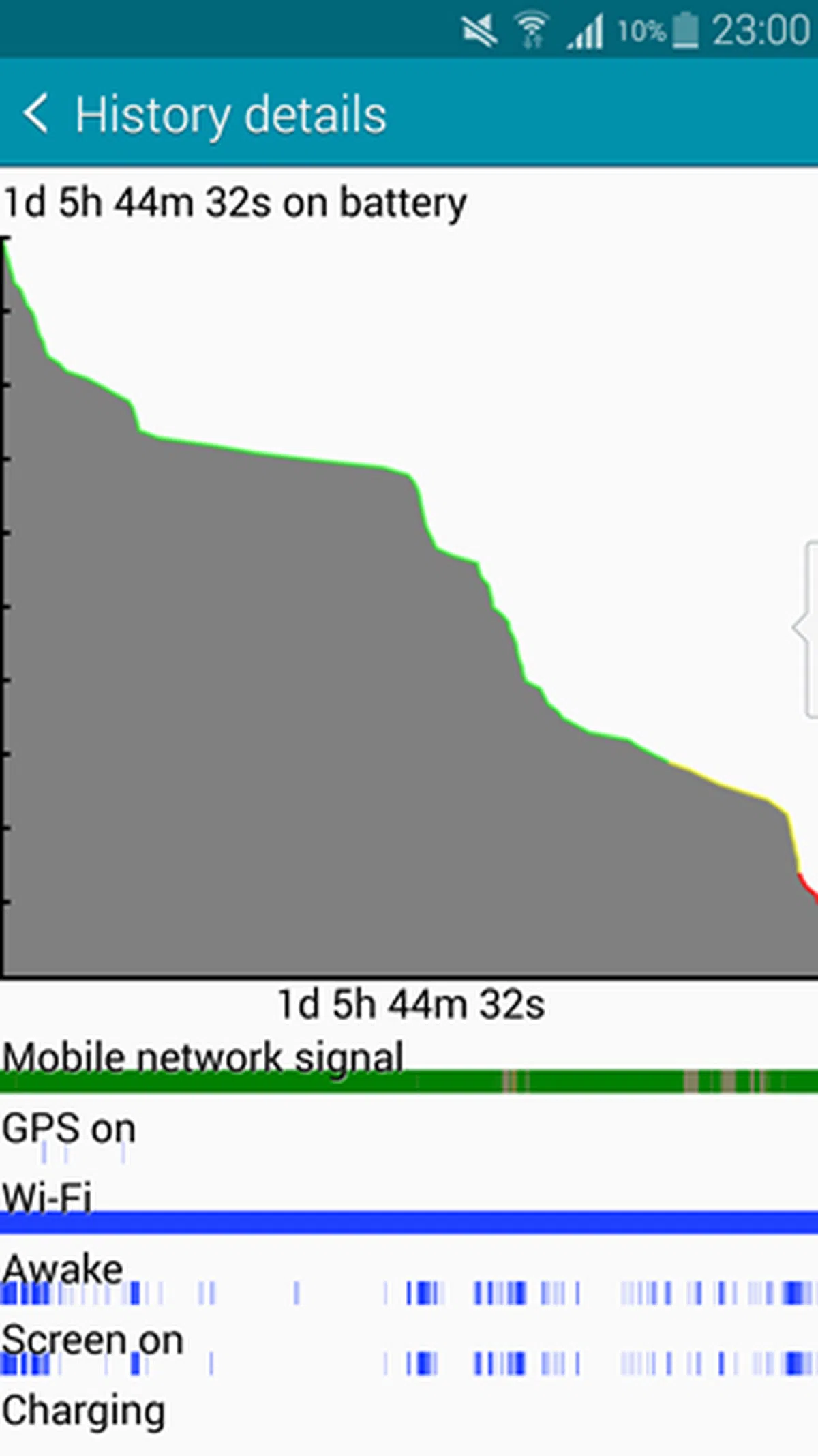 | 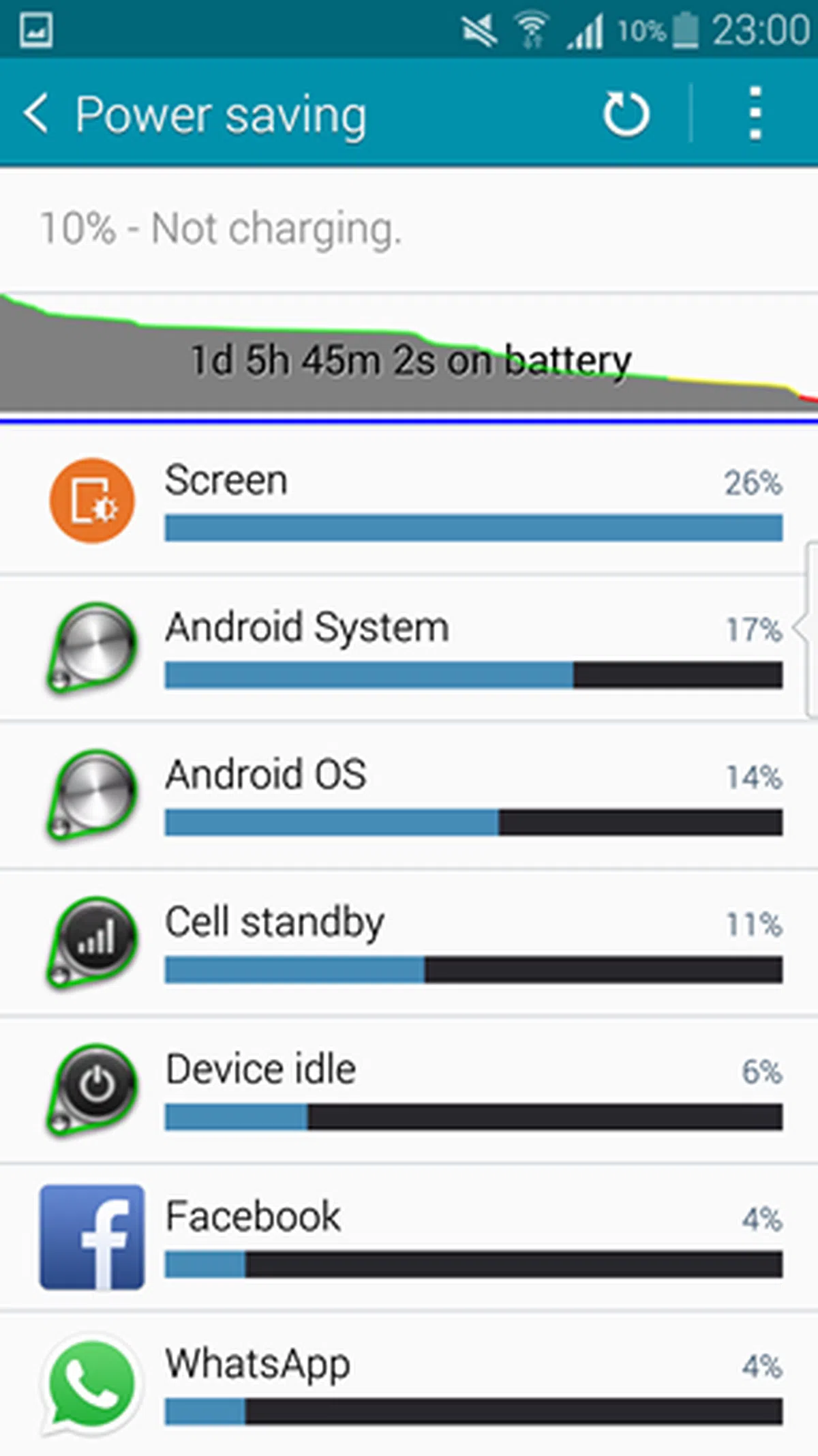 | 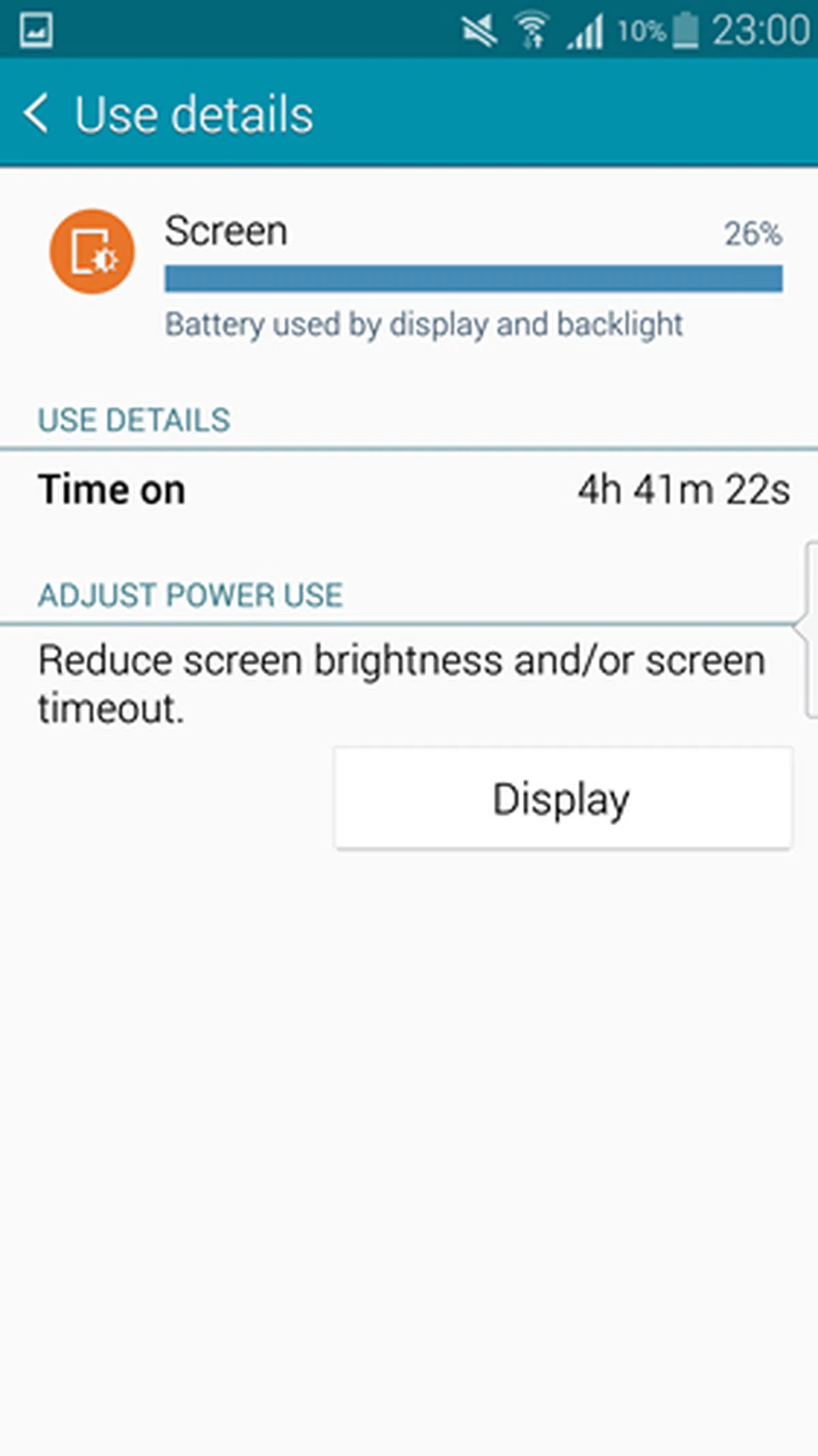 |
As seen from the graphs above, our Note 4 lasted about 30 hours (more than a day) before the battery levels dropped to 10%. Screen-on time is close to five hours. Some notes:
- The device logged onto the 3G network because the SIM card used does not support 4G LTE.
- The device logged onto Wi-Fi connections from time to time.
- Our typical usage scenarios include making voice calls, texting via WhatsApp, capturing photos and sharing them on social networking sites, the occasional web browsing via Pulse News Reader and emailing.
Do note that battery mileage varies depending on your usage patterns. Under normal usage conditions, the rear of the Note 4 did not feel warm. It only started to heat up when we ran benchmarks continuously.
To put its performance into context, the Note 3 lasted about 27 hours (3 hours less) and screen-on time is on-par. It's quite remarkable for Samsung further improve on battery life for the Note 4 considering that it has only a minor bump in battery capacity (3,220mAh from 3,200mAh), but has to power a higher resolution display and processor. When compared to its rivals, the Note 4 also fared quite well; the G3 only managed 18 hours and 30 minutes before hitting 5% with screen-on time of less than three hours, while the Find 7 clocked 13 hours and 33 minutes and a screen-on time of slightly over two and a half hours.
Fast Charging
As smartphones today get more powerful and sport higher resolution displays, it is inevitable that power consumption will go up and the battery will drain faster. Besides fitting bigger batteries, phone makers are looking at other hardware solutions to mitigate the issue.
For Samsung, the Note 4 comes with an adaptive fast charger (bundled in the retail box). In case you are wondering, the adaptive fast charging is dependent on the chipset and charger. Hence, you can use the Note 4's charger for other mobile devices, but you won't experience the same fast charging feature.
The company claims that the Note 4 can be recharged from 0% to 50% in just 30 minutes. We put it through two tests and in both, the Note 4 only managed to hit close to 40% - we got 34% on the first attempt and 39% on the second attempt - in half an hour. Subsequently, the Note 4's battery reached 70% within an hour. While this is a far cry from the Find 7's record of 82% in 37 minutes, it is still faster than most mobile chargers. We also noticed the rear of the Note 4 getting warm during the first hour of charging.
Camera Performance
Besides improving on the design and software aspects, Samsung has also made a significant improvement to the imaging capability of the Note 4. It is the first Samsung smartphone to feature optical image stabilization (dubbed Smart OIS).
There have been an increasing number of smartphones that come with OIS such as the HTC One (2013), high-end Nokia Lumia devices, the LG G3 and most recently, the iPhone 6 Plus. OIS helps take better, clearer images in low light conditions and smoother videos as it counters camera shake and increases the exposure time. Rounding off the OIS is a new 16-megapixel rear camera sensor with f/2.4 aperture and LED flash.
If you take a lot of selfies, you would be glad to know that the Note 4 has one of the better equipped front-facing cameras in the market; you get a 3.7-megapixel camera with f/1.9 aperture and a wide-selfie mode that is able to cover more with a 120-degree angle.

The camera interface on the Samsung Galaxy Note 4 is no different from that of the Galaxy S5. To access the different imaging tools, tap on Settings > Menu.

The image quality taken by the Samsung Galaxy Note 4 is really good. There is hardly any image artifacts in the darker areas and details are sharp. Color reproduction is good too. Click to view the full resolution photo.
Conclusion
Is Samsung's leadership in the phablet market threatened by the arrival of the iPhone 6 Plus and other compelling Android alternatives such as the LG G3 and Oppo Find 7? From our experience with the Galaxy Note 4, we think that Samsung would be able to survive the current onslaught.
With more than three years of experience and development, the Note 4 continues to be in a league of its own thanks to its signature S Pen and suite of software features. While previous iterations of TouchWiz and S Pen-related features were gimmicky and often viewed as bloatware, the version on the Note 4 did not disappoint in aesthetics and actual performance.
We like its modernized, flattened outlook and navigation actually feels more fluid than ever on a Samsung device. We were also impressed by the different multitasking modes offered, particularly the ease in switching between full, split, pop up and icon views. The implementation of the side key panel deserves a special mention here as it made one-handed usage of the Note 4 much easier.
Samsung also made strides in the design and build quality of the Note 4. The use of metal may be long overdue, but definitely adds a more premium finish to the Note 4. The 5.7-inch QHD display is arguably one of the best mobile displays in the industry and the use of 2.5D curved glass helps to augment the user experience.
As expected of every Samsung's flagship device, the Note 4 establishes itself as the most powerful Android smartphone in the market today. Apart from toppling benchmark after benchmark, the Note 4 also outclasses every other device on our list in battery performance. It is without a doubt the most well rounded of any phablet in the market (at the time of publishing) and we would easily recommend the Samsung Galaxy Note 4 to previous Note owners, as well as anyone comfortable with the Android camp and wants to have a big screen experience with the appropriate tools to maximize their device.
But how does it compare with the Apple iPhone 6 Plus?
Alas, if you are in the market for a premium phablet, we understand that it's hard to ignore Apple's own take, with the recently launched iPhone 6 Plus. OS preferences aside, we'll quickly run down key aspects between it and the Galaxy Note 4 to help you conclusively decide on your preferred premium phablet:-
- Design and build quality - We feel most consumers will agree that the iPhone 6 Plus boasts a more premium build. Putting #bendgate issue aside, the iPhone 6 Plus easily trumps the Note 4 with its aluminium unibody chassis. The Note 4 may have a metal frame, but its faux leather might still win some points for some depending on the preferred appearance you wish to convey. After all, your attire, body language and what you use does indirectly communicate about you.
- Display - The Note 4 gains the upper hand in both display size and resolution as the iPhone 6 Plus loses out in pixel count. However, do note that you would most likely be unable to tell the difference - apart from the slightly saturated display on the Note 4. Moreover, most apps/content are still not optimized for use with QHD displays.
- Software features/interface - Both mobile platforms have their pros and cons. If simplicity is what you look for in a mobile platform, iOS 8 may be the one you need. Samsung's TouchWiz on the other hand, has everything but the kitchen sink. Plus, you have the S Pen related features that further make the Galaxy Note 4 a much more productive tool if you get into the habit of incorporating it into your daily use. Overall, we give the nod to the Galaxy Note 4 for making a phablet device more useful than anyone has ever done to-date.
- Camera performance - Apple and Samsung clearly have differing views on imaging performance. You will not go wrong with either device, but we are leaning slightly over to the Apple's camp as the overall user experience is better.
- Battery performance - There is without a doubt that the Note 4 has the best battery life among any large screen phone you're likely to come across today (or for that matter, any phone at all). While the real world usage performance of both phones are still up for debate since personal usage experience varies greatly, the convenience of switching out the battery on the Note 4 makes us give our vote this time to Samsung.
- Usability - In all honesty, consumers should not expect to use phablets in the same manner as they do on smaller-sized devices. Nonetheless, we've seen some innovative solutions from both camps and we think that the Note 4 gives an overall better user experience for handling its large screen.
- Price - Apple's products generally cost more and this is true for the iPhone 6 Plus. The Galaxy Note 4 is only available in one variant with 32GB built-in storage capacity that costs S$1,088 whereas the retail prices of the iPhone 6 Plus starts from S$1,148 for the 16GB model. If you are tired of playing into Apple's game of having to fork out extra for more built-in storage because it's not expandable, we reckon the microSD expansion option on the Galaxy Note 4 sounds like a better and more affordable deal.
Practicality aside, we do have to make a mention of subtle intricacies that go into making the iPhone 6 Plus a more polished product from an appearance and handling point of view. The Apple product has a better build, finish and even perfects a lot of subtle design elements such as how the curved display edge meets the curved aluminum sides almost seamlessly. All of this builds into the overall experience and aura of the product which the Apple iPhone 6 and 6 Plus command and thus the higher price point as well. As such, while Apple costs more, it's arguably justifiable depending on what you need and prefer.
Our articles may contain affiliate links. If you buy through these links, we may earn a small commission.